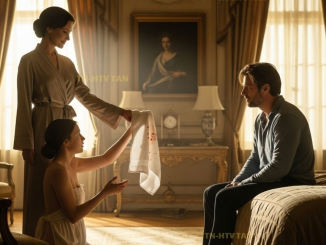It started like any other Tuesday. My daughter picked out her usual gray dress and maroon sweater, but insisted—absolutely insisted—on wearing the giant black bow headband her grandma gave her. I didn’t argue. She said it made her feel “strong like Miss Trunchbull, but in a good way,” whatever that meant.
We walked the usual two blocks to school. She skipped most of the way, humming a made-up song. I dropped her off and didn’t think much of it. But when I came back that afternoon, her teacher pulled me aside before I even reached the playground gate.
“There’s something I think you should know,” she said, kind of laughing, kind of blinking too much.
Apparently, sometime after morning circle, my daughter stood up, walked to the front of the classroom, and calmly announced, “I’m not doing this anymore.” No tantrum. No tears. Just that.
Then she sat next to a boy who barely speaks and started coloring quietly with him. For the next half hour, she ignored the class activity, made up her own, and somehow got two more kids to join. No one interrupted. Not even the teachers.
By the time the bell rang, the teaching assistant said she’d been “gently disobedient in a way that made them question the curriculum.”
Three teachers teared up during the retelling. One asked if I’d ever considered “letting her lead something.”
I laughed it off at first. But now, hours later, I’m staring at the headband on our kitchen counter, wondering if something shifted today—something I hadn’t seen coming.
That night, I asked her about it over dinner. She was dunking carrot sticks into hummus with an unusual level of concentration. “Why did you say you weren’t doing it anymore?” I asked.
She shrugged. “I didn’t like the book we were reading. It made Jamal sad. So I thought maybe we could just color instead.”
I frowned. “The boy you sat next to?”
She nodded. “He doesn’t talk much. But he colors super nice. So I asked if I could join him, and then Mila and Hugo came too. I told them they didn’t have to sit on the rug if they didn’t want to.”
That’s when I realized something strange. My daughter wasn’t being rebellious. She was… choosing kindness over routine. It wasn’t a protest. It was compassion.
Still, I didn’t want to read too much into it. Kids do weird things all the time. I figured maybe this was just one of those days.
But then came Wednesday.
When I dropped her off, the principal herself greeted us at the gate. She smiled at my daughter like she was royalty and said, “We’re so glad to see you today, Miss Marlowe.”
I blinked. Miss Marlowe?
The principal handed me a flier. “We’re trying something new this morning. Inspired by your daughter’s… leadership yesterday.”
It was titled “Creative Choice Hour,” and apparently my daughter would be co-leading it—with the art teacher.
That night, Marlowe told me they sat in a circle, listened to how everyone was feeling, and then chose activities based on the group’s mood. “We painted clouds because Hugo was tired, and clouds feel soft,” she said, as if it was the most natural thing in the world.
By Friday, she had a corner of the classroom rearranged into what she called “The Calm Cave,” complete with blankets, headphones, and books without words. The school counselor stopped me at pickup to ask if I’d ever considered enrolling her in gifted programs—not for academics, but for emotional intelligence.
At first, I was flattered. Proud, even. But by the next week, something about it all started to make me nervous.
She was six. Six. And people were looking at her like she had some kind of magic.
They didn’t see the way she melted down if her socks felt weird. Or how she refused to eat sandwiches if they were cut the “wrong” way. They didn’t hear the midnight sobs when her dreams got too loud. They saw a tiny rebel with a black bow and assumed she had it all figured out.
I knew better. I knew she was still learning how to be in the world.
The attention kept growing. One mom asked if Marlowe could “mentor” her daughter. A local blogger wrote a post calling her “The Empathy Whisperer.” Even the superintendent came by to watch her lead an activity where kids wrote apologies to the earth and buried them in the school garden.
Then came the twist I didn’t expect.
A few weeks later, I got a call from the teacher. “Marlowe didn’t want to come out of The Calm Cave today,” she said gently. “She was curled up and wouldn’t talk. We didn’t push her.”
When I picked her up, she looked tired. Like bone-deep tired. I carried her home, something I hadn’t done in over a year. She leaned her head on my shoulder the whole walk.
That evening, over apple slices and cinnamon toast, she finally spoke.
“I don’t want to fix everyone all the time,” she whispered.
I froze.
“Everyone keeps coming to me,” she said. “They tell me their problems, and then they feel better. But I feel worse. My tummy hurts. And I think I made Hugo sad again ‘cause I didn’t have time to sit with him today.”
I swallowed hard. She wasn’t a child with superpowers. She was a sponge—soaking up everyone else’s pain and trying to make it better. But nobody had taught her how to wring herself out.
We stopped the creative hour the next day. With the school’s support, we replaced it with a rotation system—every week, a different student could lead a short morning warm-up if they wanted. No pressure. No expectations.
Marlowe still wore her bow sometimes, but only when she felt strong. Other days, she picked a baseball cap or just nothing at all. And slowly, she learned to say no.
We put a sign on her bedroom door: “Today, I’m just Marlowe.” And sometimes, that’s all she wanted to be.
Months passed. The school adapted. Teachers started giving kids more freedom to self-select activities. They created emotion boards and built quiet nooks in every classroom. It wasn’t all because of Marlowe—but she had started something.
One day, a girl named Lila stood up in class and said she didn’t want to do math drills because she missed her cat. The teacher let her write a poem about her cat instead.
That was the real change. Not a six-year-old becoming a guru. But a school remembering that feelings matter, too.
And that’s when the karmic twist came full circle.
It was Grandparents’ Day, and my mom came to visit the classroom. Marlowe insisted she wear the black headband—“for strength,” she said, grinning. My mom laughed but put it on.
During snack time, one of the boys, Jamal—the quiet one—walked up to my mom and handed her a drawing. It was her, wearing the bow, standing in a garden. Above it, he’d written: “Thank you for giving her the magic.”
My mom cried. A full, shaky, unexpected cry.
Later, she told me, “I gave her that headband because I was scared she wouldn’t be strong enough in the world. But I think I forgot—strength doesn’t always mean loud. Sometimes it means knowing when to stop and just be.”
That stuck with me.
We talk so much about raising leaders. Brave kids. Smart kids. But sometimes, the bravest thing a kid can do is say, “I’m tired.” Or, “I need a minute.” Or, “I want to help, but not today.”
Marlowe is older now. She still wears the bow sometimes, though it’s a bit floppy from years of love. But she also knows it’s okay to take it off. To not carry the world on her tiny shoulders.
We still walk to school together. She still hums made-up songs. But now I pay more attention to the quiet moments. The coloring. The listening. The small choices that shape a person more than any spotlight ever could.
If there’s one thing I’ve learned, it’s this: kids don’t need to be extraordinary to be worth celebrating. Let them be soft. Let them be silly. Let them rest. Let them lead when they want—and just be when they don’t.
Sometimes, the most important lessons don’t come from textbooks or lectures. Sometimes, they come from a little girl in a giant black bow who decides, one Tuesday morning, that the world could be kinder—and quietly dares it to change.
So yeah. Something did shift that day.
But maybe it wasn’t her.
Maybe it was all of us.
If this story touched you, made you smile, or reminded you of someone you love—share it. Let more people know that being gentle can still change the world. And maybe, just maybe, the strongest leaders are the ones who lead with heart.
Like. Share. Pass it on.






Leave a Reply